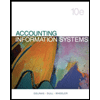
Concept explainers
TM Office Supplies, Inc., is a wholesale distributor of office supplies. It sells pencils and pens, paper goods (including computer paper and forms), staplers, calendars, and other items, excluding furniture and other major items such as copy machines that you would expect to find in an office. Sales have been growing at 5 percent per year during the past several years. Mr. Marina, the president of TM Office Supplies, recently attended a national office supplies convention. In conversations during that convention, he discovered that sales for TM Office Supplies’ competitors have been growing at 15 percent per year. Arriving back home, he did a quick investigation and discovered the following:
- TM Office Supplies’ customer turnover is significantly higher than the industry average.
- TM Office Supplies’ vendor turnover is significantly lower than the industry average.
- The new market analysis system was supposed to be ready two years ago but has been delayed for more than one year in systems development.
- A staff position, reporting to the president, for a person to prepare and analyze cash budgets was created two years ago but has never been filled.
Mr. Marina has called on you to conduct a systems survey of this situation. You are to assume that a request for systems development has been prepared and approved. The information system at TM Office Supplies is much like that depicted in Chapters 10 through 16.
Make and describe all assumptions that you believe are necessary to solve any of the following:
- a. What are the specific tasks of this systems survey?
- b. Indicate specific quantifiable benefits and costs that should be examined in assessing the economic feasibility of any solutions that might be proposed. Explain how you would go about quantifying each benefit or cost.
- c. Propose and explain three different scopes for the systems analysis. Use a context diagram to describe each scope alternative. Hint: What subsystems might be involved in an analysis?
Trending nowThis is a popular solution!

Chapter 17 Solutions
Accounting Information Systems
- I mistakenly submitted blurr image please comment i will write values. please dont Solve with incorrect values otherwise unhelpful. hiarrow_forwardHello tutor i need help I mistakenly submitted blurr image please comment i will write values. please dont Solve with incorrect values otherwise unhelpful.arrow_forwardNeed help with appropriate method please I will unhelpful if you use wrong values .arrow_forward
- Solve this question with financial accounting questionarrow_forwardI need help with this situation and financial accounting questionarrow_forwardRemaining Time: 50 minutes, 26 seconds. * Question Completion Status: A Moving to the next question prevents changes to this answer. Question 9 Question 9 of 20 5 points Save Answer A currency speculator wants to speculate on the future movements of the €. The speculator expects the € to appreciate in the near future and decides to concentrate on the nearby contract. The broker requires a 2% Initial Margin (IM) and the Maintenance Margin (MM) is 75% of IM. Following € Futures quotes are currently available from the Chicago Mercantile Exchange (CME). Euro (CME)- €125,000; $/€ Open High Low Settle Change Open Interest June 1.2216 1.2276 1.2175 1.2259 -0.0018 Sept 1.2229 1.2288 1.2189 1.2269 0.0018 255,420 19,335 In addition to the information provided above, consider the following CME quotes that are available at the end of day one's trading: Euro (CME) - €125,000; $/€ Open High Low June 1.2216 Sept 1.2229 1.2276 1.2288 Settle Change Open Interest 1.2175 1.2176 -0.0083 255,420 1.2189…arrow_forward
 Pkg Acc Infor Systems MS VISIO CDFinanceISBN:9781133935940Author:Ulric J. GelinasPublisher:CENGAGE L
Pkg Acc Infor Systems MS VISIO CDFinanceISBN:9781133935940Author:Ulric J. GelinasPublisher:CENGAGE L Cornerstones of Cost Management (Cornerstones Ser...AccountingISBN:9781305970663Author:Don R. Hansen, Maryanne M. MowenPublisher:Cengage Learning
Cornerstones of Cost Management (Cornerstones Ser...AccountingISBN:9781305970663Author:Don R. Hansen, Maryanne M. MowenPublisher:Cengage Learning Essentials of Business Analytics (MindTap Course ...StatisticsISBN:9781305627734Author:Jeffrey D. Camm, James J. Cochran, Michael J. Fry, Jeffrey W. Ohlmann, David R. AndersonPublisher:Cengage Learning
Essentials of Business Analytics (MindTap Course ...StatisticsISBN:9781305627734Author:Jeffrey D. Camm, James J. Cochran, Michael J. Fry, Jeffrey W. Ohlmann, David R. AndersonPublisher:Cengage Learning


